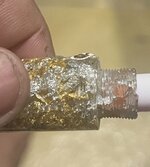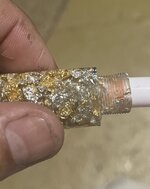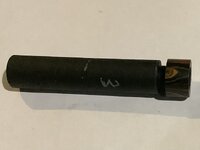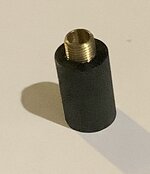I bought these blanks from Turners warehouse( Top choice ) few months ago and happened to turn them yesterday . Both of them failed in identical ways , a brittle failure . Out of curiosity, I investigated in depth and found the following . Don't know whether there is any special care for handling these shining and shimmering blanks which have gold and silver or probably mica particles suspended in the epoxy matrix .
1. During drilling operations , I did not get any curly flakes but was almost powdery always .
2. Dusing tenon cutting , it was curly material all over .
3. Cracks appeared after the banks were turned and set aside .
4. The centre part of the round blank had segregation which meant the suspended shiny particles were floating while the centre was mostly resin.
5. Cracks appeared on the threaded area wherever there were minimum particles from where the fault-lines appeared .
Are there any special instructions to be followed for turning or this is a case of avoiding such blanks completely .After blowing up 30bucks , I have decided not to turn these blanks anymore . If there are any individuals who interact with Chad , please do take it up with them else very this should serve as a caution .
mohan
1. During drilling operations , I did not get any curly flakes but was almost powdery always .
2. Dusing tenon cutting , it was curly material all over .
3. Cracks appeared after the banks were turned and set aside .
4. The centre part of the round blank had segregation which meant the suspended shiny particles were floating while the centre was mostly resin.
5. Cracks appeared on the threaded area wherever there were minimum particles from where the fault-lines appeared .
Are there any special instructions to be followed for turning or this is a case of avoiding such blanks completely .After blowing up 30bucks , I have decided not to turn these blanks anymore . If there are any individuals who interact with Chad , please do take it up with them else very this should serve as a caution .
mohan




